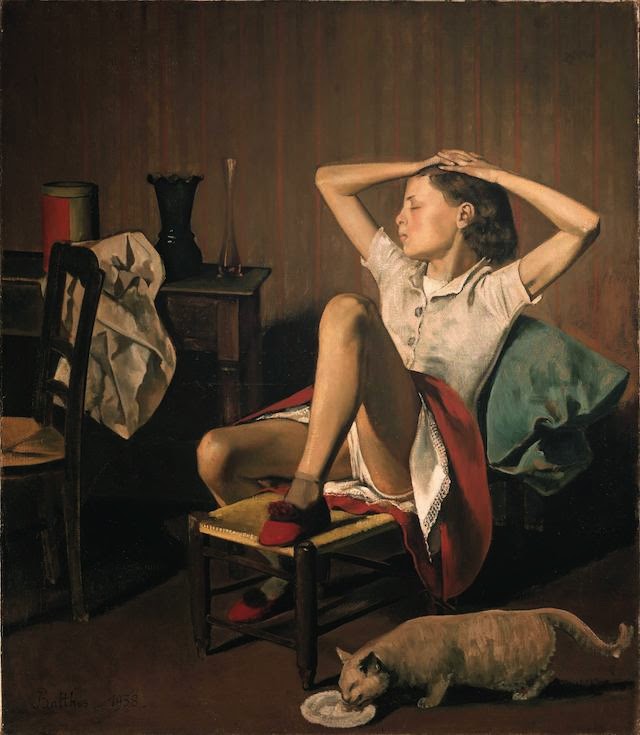Thérèse
Dreaming, Balthus (Balthasar Klossowski) 1938, Oil on canvas, 1999.363.2
Cats
are a frequent theme in Balthus’s paintings. In the case of Thérèse Dreaming
the cat is subtle and fits naturally into the painting, other times Balthus
paints a cat as the subject matter and even in one case paints a cat’s head
onto a human body. Balthus’s obsession with cats started at an early age when
at the age of 11 he lost his cat Mitsou and did a series of 40 ink drawing to
commemorating the lose. We can assume
that Balthus’s later use of cats in his artwork is a symbol of sexuality as he
often pairs them with young girls in suggestive poses.
Olympia,
Edouard Manet, 1863, Oil on canvas, Musée d'Orsay Museum
This
painting caused much unrest when first showed in the salon in 1865. Manet uses the classic pose of an odalisque
to paint a white prostitute instead. Manet chooses to force the viewer to
understand this painting as a prostitute by including the black cat among the
symbolism; a blatant symbol of prostitution and sensuality. Manet uses the cat
in much the same way as Balthus by fitting it into the scenery of the painting
naturally but intentionally.
Still Life with Cat and Fish, Clara Peeters, after 1680, Oil
on Panel, National Museum of Women in the Arts
One must be careful not to over-symbolize the objects in a
still life. Nonetheless, this still life contains a cat and oysters, both
symbols of lust and sensuality. Clara Peeters is likely making a moral
statement with this still life that is common of Dutch still life but unique in
comparison to the other paintings in this gallery. Her use of the different
objects is also likely an example of her mastery of the use of paint. She shows
her versatility as an artist by including fur, scales, and shells in detail. This
is not the same reason other artists in this gallery choose to place a cat in
their work.
Sleeping Girl with Cat, Pierre-Auguste Renoir, 1880, Oil on
canvas, Sterling and Francine Clark Art Institute
This painting is one of several paintings Renoir does with
cats included in the subject matter. Like most paintings that include a cat
this one includes a girl. Here we see a
cat and a girl both in a restful state, fully relaxed and vulnerable. Similarly
to Therese Dreaming the girl is in a
lounging state and seems unaware of her surroundings. The cat however is in a
restful state unlike the cat Balthus paints in Therese Dreaming that is unaware
of the girl as it laps up milk on the floor. The girl and the cat in this
picture seem to have a much more personal relationship and a much more relaxed
existence.
The Bridge, Carl Larsson, 1912, Watercolor, Private collection
This painting explores a more innocent side to using a cat
as a symbol. This painting adds a lighthearted facet to the use of a cat as a
symbol. The cat and the girl both seem entranced in curiosity towards a distant
male figure. The cat offers a comparison to the spying girl and adds to the
innocence of this young girl. This painting is cheerful and lighthearted and
uses the cat in a much different way than Balthus uses in Therese Dreaming.
Kees van Dongen, Woman with Cat, 1908, Oil on canvas, Milwaukee
Art Museum
Unlike Therese
Dreaming this painting shows a woman rather than a girl and shows her
facing the viewer. The woman is dressed confidently with a flamboyant hat but
is clutching onto the cat in a way that suggests she is hiding behind it. The
style of this painting is obviously quite different from the way Balthus paints
and gives the painting less of a dark undertone. Like Thérèse Dreaming
it is still
mysterious and compelling to look at this woman and think about her
relationship with the cat she is clutching onto.

The Cat is also included in most paintings and woodcuts of alleged witches, But modern Neopagan witches are no more prone to cat-keeping to the wider population,
ReplyDelete